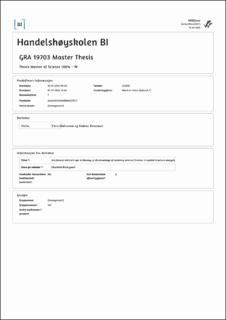Are female-led start-ups in Norway at disadvantage of receiving external finance: A capital structure analysis
Master thesis
Permanent lenke
https://hdl.handle.net/11250/3037190Utgivelsesdato
2022Metadata
Vis full innførselSamlinger
- Master of Science [1621]
Sammendrag
Gender discrimination has gained a lot of attention more recently when it comes to
receiving external finance. Despite Norway ranking third in closing the gender gap,
statistics from Nordic countries find that male founded firms receive most of the
capital allocated to start-ups. Thus, the motivation for this thesis is to explore
whether female-led start-ups in Norway are at a disadvantage of receiving external
finance according to their capital structure. Firms with similar expected risk and
return should be equally appealing to investors. However, previous research has
shown that this is not the case, suggesting that gender may explain why we
observe this funding gap. By using accounting data from the time period 2010-2020
obtained from The Centre for Corporate Governance (CCGR), this thesis aims to
examine how gender affect a start-ups ability to receive external funding. This will
be accomplished by examining how male- and female-led start-ups differ in their
capital structure in terms of total leverage and short-term leverage, as well as how
gender-dominated industries may reverse the relationship. This thesis find that
gender does not appear to be an important factor in explaining funding differences.
However, contrary to our predictions, we observe that female-led start-ups have a
minor advantage in acquiring external funding. Despite this, we cannot draw any
definite conclusions from these findings since we do not know if it is a result of
discrimination or a self-made decision.
Beskrivelse
Masteroppgave(MSc) in Master of Science in Business, Finance - Handelshøyskolen BI, 2022
